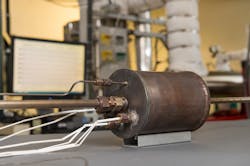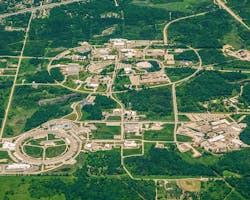Thermal Storage Technology Recovers Untapped Energy Source
The heat generated at factories and power plants by heavy-duty vehicles and certain other systems is often wasted. Around 60% of energy from combustion processes alone is lost in the form of heat.
What if it were possible to capture heat and use it as a source of energy? Researchers at the U.S. Department of Energy’s (DOE) Argonne National Laboratory had this in mind when they developed the award-winning Thermal Energy Storage System (TESS).
Researchers were specifically looking for a way to store thermal energy at concentrating solar-thermal plants (CSP) when they came up with the idea for TESS. CSP plants generate electricity from solar power and operate at extremely high temperatures. Thermal storage is used at these plants to store heat generated when the sun is out so that power can be generated at night and on cloudy days.
TESS can be used at solar power plants and other manufacturing facilities to reduce operating costs by recovering and reusing wasted heat. Argonne Senior Scientist Dileep Singh, who leads the development of TESS, describes the technology as a thermal battery. Just as a traditional battery discharges and charges electricity, TESS discharges and charges heat.
TESS lends itself to wide-ranging commercial applications. By enhancing the performance and efficiency of combined heat and power (CHP) systems, the TESS can help power plants or other industrial, thermally-driven facilities run more efficiently by capturing the heat emitted during the day and using it at night.
“Storing thermal energy and using it during periods of high electricity pricing can result in significant cost savings,” Singh said. “This is particularly important for process and manufacturing industries and in building applications, as it reduces operating costs and increases energy efficiency.”
TESS can potentially be used in heavy-duty trucks or electric vehicles to convert heat into mechanical energy or cabin heating. The system’s ability to release heat quickly may also help it regulate the heating and cooling of commercial buildings.
“TESS can be an energy-efficient and cost-effective option for many different industrial processes because it is tunable to work in different temperatures and has a unique modular design,” Singh said.
How it works
TESS rapidly stores and releases waste heat that can later be used for a variety of applications. As a single unit, it is about the size of a trash bin. Inside of TESS, there is phase-change material infused into a uniquely designed thermally conductive foam core. The phase-change material, adapted to specific operating temperature ranges, melts when heated and re-solidifies when cooled. The foam core efficiently exchanges heat.
Advantages of the system
Three major advantages of TESS are its tunability, modularity, and efficiency, which increase its cost-effectiveness.
Researchers can customize TESS to work for different applications by selecting specific phase-change materials, making it adaptable to many industrial processes.
The thermally conductive foam core makes TESS highly efficient compared with similar technologies. TESS also has high energy density, which results in a more compact footprint compared with other commonly used heat storage systems.
TESS has a modular design which makes it adaptable for manufacturers. Instead of requiring huge storage structures to contain the system, facilities can produce units in manageable sizes and install the number that they need.
Next steps
Since it was developed, TESS has been recognized as a novel breakthrough in thermal storage by both industry and government alike. In 2019 the technology was awarded an R&D 100 Award—sometimes called the “Oscars of Innovation”—which honors revolutionary ideas in science and technology.
Argonne’s researchers were also awarded funding from the DOE Technology Commercialization Fund to refine the technology further. With this funding, Singh and fellow researchers are working with Capstone, which manufactures CHP microturbines. With TESS, the heat recovered from the operation of a CHP can be recovered and used. The Argonne team has also developed an in-house testing facility to test performance over multiple charge and discharge cycles.
Companies interested in licensing or partnering on this technology can email [email protected].
Argonne National Laboratory’s work to develop TESS is funded by the DOE Energy Efficiency and Renewable Energy’s Solar Energy Technologies Office.

